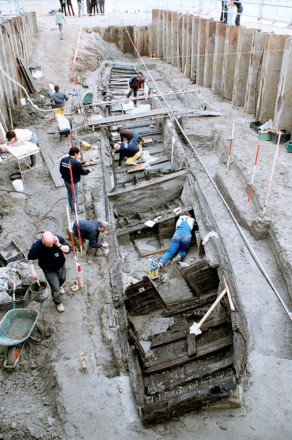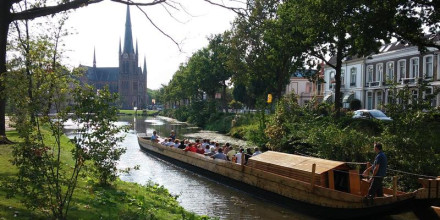History
Discovery
Mr. H. Joosten, a member of a local historical society, found wood belonging to a shipwreck in a small hole that was being dug in 1997. Shortly before that, construction elements of a Roman road had been found in the same area. The finds were reported to the predecessor of the Cultural Heritage Agency of the Netherlands (then called ROB). The wreck was called Meern 1 and turned out to be one of the best preserved Roman ships ever found.
Wreck
It turned out that the wood belonged to a Roman flat bottomed vessel intended for river shipping. It had had a fairly luxurious cabin with a bed and a chest for storing goods and a separate galley. Much of the structure remained intact and the presence of many tools and personal possessions in the wreck indicates that it sank due to an accident and was not sunk intentionally as is often the case with wrecks of this type. A possibility is that it sank due to a flood wave that came in from the sea in winter.
The crew
The skipper was possibly a carpenter who had manufactured his own furniture and also performed repairs on the boat. A toolbox was discovered near the vessel. Remains of two larger pairs of shoes have been found in the cabin. Just outside the boat a smaller pair emerged suggesting a second crew member; a boy or a woman.
Three Roman styluses were discovered in the cabin. This suggests that someone on board knew how to read and write, which was fairly uncommon in that period. It is possible that the ship carried Roman troops, or that the skipper was a veteran or a romanised local Batavi, trading and traveling between Roman military posts.
The Roman border (limes)
From ca. 50 until 230 AD the lower Rhine in the Netherlands was part of the border of the Roman empire (limes). There were about twenty Roman fortresses (castelli) along the Rhine in the Netherlands to guard the border. Traffic and trade was intense. The Meern 1 was operating in the region between 150-200 AD. It is possible that it was a military supply vessel at first and that it functioned as a civilian freighter supplying army posts on the limes with goods and people in its later days.
Description
Type: Roman flat-bottomed boat/river barge, similar to the Zwammerdam ships .
Propulsion: sail, oars.
It was constructed in the shell first method and has both Mediterranean and local building features.
Material: oak.
The ship has an shape and was built from high quality oak. Its narrow width/length proportions (1:9,1) indicate that the vessel was not a regular bulk freighter, but was more likely used for mail, light cargo and personnel on short voyages on the Rhine.

| People on board | 2 |
|---|---|
| Length | 82 feet (25 m) |
| Width | 8 ¾ feet (2.7 m) |
Status
Excavation and construction
After the reporting of the wreck, an exploratory investigation was done which ended on 4 December 1997. The excavation of the wreck, on behalf of the municipality of Utrecht, followed in 2003. It was led by archaeologist A. van Holk of the ROB. The public was kept informed of the process with a website and a webcam and a few open days were organised.

The knees of the head are set in pairs and a space for a mast step was put into one of these. It was built with the hull first method, where the skin of the ship is built first and the frames are fitted in later. This was learned from nail holes of the temporary frames used in the build. A unique feature of this wreck is that the deck cabin for the crew and the galley were found intact, and that a large part of the inventory was present in the vessel.
Dating
More recent research into the provenance of the wood indicates that this came from Flanders in the north of Belgium and was cut around 148 AD. Together with finds from the ship, especially shoes found in the cabin, the date of the demise of the ship is put at around 200 AD (see Romeinse Scheepsresten in Nederland under references).
Preservation
After excavation, the wreck was lifted in its entirety and transferred to the archaeological workshop in Lelystad for conservation and research, led by E. Jansma. In 2015, the wreck was transferred to Museum Hoge Woerd in de Meern, where it is on display with the artefacts found in the wreck. A replica of the ship that is used for tours was built by the Stichting Romeinse Schepen Utrecht (Roman ships foundation Utrecht).

References
- erfgoed Utrecht.
3 D model of the Meern 1 inside. - Brouwers, W. , Jansma, E. Manders, M.
Romeinse scheepsresten in Nederland. - Jansma, E./J.Morel (2007).
Een Romeinse Rijnaak, gevonden in Utrecht-De Meern, RAM 144.
Amersfoort, Rijksdienst voor het Cultureel Erfgoed. - PAN.
Portable Antiquities Network.